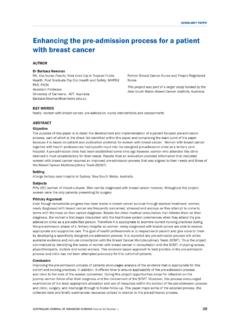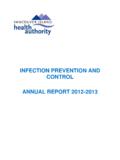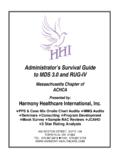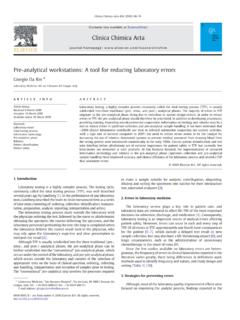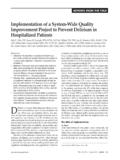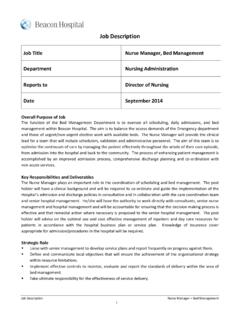Transcription of Lourdes Orthopaedic Hospital, Kilcreene
1 1 Hygiene Services Assessment Scheme Assessment Report October 2007 Lourdes Orthopaedic hospital , Kilcreene , Co Kilkenny 2 Table of Contents Executive Summary ..3 Organisational Profile ..7 Best Practice ..7 Priority Quality Improvement Plan ..7 Hygiene Services Assessment Scheme Overall Score ..9 Standards for Corporate Standards for Service Appendix Service Delivery Core Criterion ..21 Appendix Ratings Summary ..29 Ratings Details ..29 Executive Summary Introduction This is the first National Hygiene Services Assessment Scheme (HSAS.) It is a mandatory scheme for all acute hospitals. The scheme aims to enhance cultural change in the area of hygiene services by not only focusing on the service delivery elements but also emphasising the importance of standards for corporate management. The HSAS is a patient-centred scheme which assists a hospital to prioritise the key areas in hygiene to be addressed.
2 It is intended to promote a culture of best practice and continuous quality improvement. The Irish Health Services Accreditation Board developed these, the first set of National Hygiene Assessment Standards in 2006. This development plan involved an extensive desktop review of national and international best practice literature, working groups and extensive consultation. The feedback from these development components formed the final draft Standards and Assessment Process, which were then piloted in a number of acute hospitals. (The Irish Health Services Accreditation Board was subsumed into the Health Information and Quality Authority in May 2007.) The Hygiene Services Assessment Scheme (HSAS) was launched by the Minister for Health Mary Harney on the 6th November 2006. Hygiene is defined as: The practice that serves to keep people and environments clean and prevent infection. It involves the study of preserving one s health, preventing the spread of disease, and recognising, evaluating and controlling health hazards.
3 In the healthcare setting it incorporates the following key areas: environment and facilities, hand hygiene, catering, management of laundry, waste and sharps, and equipment 1-4 More specifically, the Hygiene Services Assessment Scheme incorporates the following: Environment and Facilities: incorporates the condition of the building and all its fixtures, fittings and furnishings. Hand Hygiene: incorporates hand washing, antiseptic hand-rub and surgical hand antisepsis. Catering: incorporates kitchens (including ward kitchens) fixtures and fittings and food safety. Management of Laundry: incorporates management of linen and soft furnishings both in-house laundry and external facilities. Waste and Sharps: incorporates handling, segregation, storage and transportation. Equipment: incorporates patient, organisational, medical and cleaning equipment. Standards Overview The standards are divided into two sections: Corporate Management and Service Delivery.
4 Each standard is divided into a number of criteria. These are specific steps, activities or decisions that must occur to achieve the standard. 4 The 14 Corporate Management standards facilitate the assessment of performance with respect to hygiene services provision to the organisation and patient clients at organisational management level. These standards commence at the planning stage and follow through to governing, implementation and evaluation. They incorporate four critical areas: Leadership and Partnerships Management of the Environment and Facilities Management of Human Resources Information Management. The six Service Delivery standards facilitate the assessment of performance at team level. The standards address the following areas: Evidence based best practice and new interventions Prevention and Health Promotion Integration and coordination of hygiene services Implementing safe, efficient and effective hygiene services Protection of patient/clients rights Assessing and Improving performance.
5 5 The standards and process have been assessed and internationally accredited by the International Society for Quality in Healthcare (ISQua). Core Criteria: To ensure that there is a continual focus on the principal areas of the service, 15 core criteria have been identified within the standards to help the organisation and the hygiene services to prioritise areas of particular significance. In the Corporate Management standards, the core criteria cover: Allocation of resources, accountability, risk management, contract management and human resource management. In the Service Delivery standards, core criteria cover: Waste management, hand hygiene, kitchens and catering, management of linen, equipment, medical and cleaning devices and the organisation s physical environment. Rating Scale The rating of individual criterion is designed to assist self-assessment teams and the organisation in general, to prioritise areas for development.
6 The rating for the criterion can be determined based on the percentage level of compliance. The rating scale utilised by the Hygiene Services Assessment Process is a five-point scale: A Compliant - Exceptional There is evidence of exceptional compliance (greater than 85%) with the criterion provisions. B Compliant - Extensive There is evidence of extensive compliance (between 66% and 85%) with the criterion provisions. 5C Compliant - Broad There is evidence of broad compliance (between 41% and 65%) with the criterion provisions. D Minor Compliance There is evidence of only minor compliance (between 15% and 40%) with the criterion provisions. E No Compliance Only negligible compliance (less than 15%) with the criterion provisions is discernible. N/A Not Applicable The criterion does not apply to the areas covered by the Self Assessment Team. Rationale must be provided. This cannot be used for a core criterion. Assessment process components The assessment process involves four distinct components: Preparation and self assessment undertaken by the organisation.
7 The self-assessment process allows an organisation to systematically evaluate its hygiene services against a set of best practice standards. This was completed by a multidisciplinary team(s) over a period of two months. This process was preceded by regional education sessions. Unannounced assessment undertaken by a team of external assessors The HIQA has recruited senior professionals from the areas of medicine, nursing and corporate management as assessors, in addition to independent senior professionals with specialist knowledge in the core areas. To assure consistency across all sites four leaders were chosen from this group to cover all unannounced visits. The assessor s performance was regularly evaluated based on feedback from participating organisations, HIQA staff and other assessors. Site visits for the larger academic teaching hospitals were completed over days with four assessors, and assessments were completed in the smaller hospitals over 2 days with three assessors.
8 The assessment team were responsible for identifying the organisation s compliance with the standards and helping to guide its improvement. The assessment included a comprehensive documentation review, meetings with management, staff and patients. Throughout the assessment process the assessors worked as a team to cross reference their findings. This ensured that the ratings for each criterion were agreed upon and reflected an accurate picture of the organisation s level of compliance. Feedback was provided to the Chief Executive / General Manager and senior management team by the Assessment Team Leader, at the end of each day of the assessment. Provision of an outcome report and determination of award status. The Internal Review Committee of the HIQA reviewed all the reports to ensure consistency, and based on the quantifiable translation guidelines, awards were made. Only organisation s which received a very good score were acknowledged with an award for the duration of one year.
9 By the end of 6 October 2007 all 51 acute care hospitals had received a copy of their individual report. At the same time the HIQA launched a National Report of the findings of all assessment reports. These standards are different from the first two hygiene audits, therefore a direct correlation of results were not possible. Continuous Improvement Going forward a quality improvement plan should now be structured from the self assessment and recommendations from the external report. This will then be monitored by the HIQA. The areas of notable practice, quality improvement plans, areas of priority action, overall score, criterion ratings and comment and are presented in the following pages of the report. 1 Boot, M and Cairncross, S Actions Speak Delft, The Netherlands, IRC and LSTHM, British Occupational Hygiene Society. 2 New York Department of Health and Mental Hygiene 3 The Columbia Electronic Encyclopaedia, Sixth Edition.
10 Columbia University Press. 2003 4 Irish Acute Hospitals Cleaning Manual, HSE (2006) 5 Hygiene Services Assessment Scheme. Irish Health Services Accreditation Board (2006) Organisational Profile Lourdes Regional Orthopaedic hospital , Kilcreene has bed capacity of 51 for elective Orthopaedic services providing a service to the South Eastern region of Ireland. It covers the counties of Waterford, Wexford, Kilkenny, Carlow and South Tipperary, serving a population of 430,000. Lourdes Orthopaedic hospital Kilcreene has links with St Luke's hospital Kilkenny through its Corporate Management Structures. Services provided Pre-operative assessment, fracture clinic, diabetic and other specialist clinics are held on site. Waterford Regional hospital provides elective services at Kilcreene including hip and knee joint replacements. Consultant Orthopaedic Surgeons for the region are based at Waterford Regional hospital , but perform their elective surgery in Kilcreene hospital .
